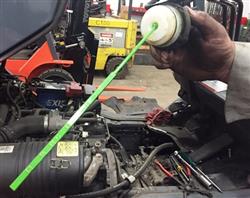FAQS: How to Know if the Hydraulic Fluid is Low in your Forklift

One of the most common questions we get in the service department is “How do I know if know if my hydraulic fluid is low and how do I check it?”
Forklifts rely on hydraulics for their lifting and steering abilities. Having the right amount of hydraulic fluid in a forklift’s reservoir ensures the forklift’s lifting and steering abilities. Too much fluid in the tank will cause as leaks and spills.
The forklift operator is supposed to check the hydraulic fluid as part of the pre-shift inspection. Because there can be lots of different markings on the dipstick, it’s vital to know which mark to use in the measurement.
OEMs often use the same dipstick for various models. For example, Toyota 7 Series trucks use the same dipstick for cushion and pneumatic tire trucks with masts ranging from single to triple stage. One side is marked P1, P2, P3 while the other side is marked C2, C3. The P side is used pneumatic tire forklifts, the C side is for cushion tire trucks. The numbers 1, 2 and 3 refer to the number of lift stages on the mast. Consult your owners manual or your local dealer to determine which mark to use.
- Park on level ground
- Lower the forks to the ground and in a level position, not tilted forward or back. When they are elevated or tilted, some of the hydraulic fluid will be in the lift cylinders and you won’t get an accurate reading.
- If you don’t know where the dipstick is, consult your owner’s manual for the location of the hydraulic tank.
- Pull the dipstick and check the level.
- Use caution when adding fluid – make sure you use the fluid recommended by the manufacturer. Putting the wrong stuff in will lead to very poor results.
Most manufacturers recommend replacing a forklift’s hydraulic oil every 1,000 hours of use. Keep your machines running right with regular fluid checks, filter replacements and routine inspections.
Contact your nearest JIT Toyota-Lift Service Department for more information.
- Buffalo NY: (716) 893-6105
- Jamestown NY: (833) 311-5534
Thanks goes to Scott Sadowski for contributing to today’s blog post
